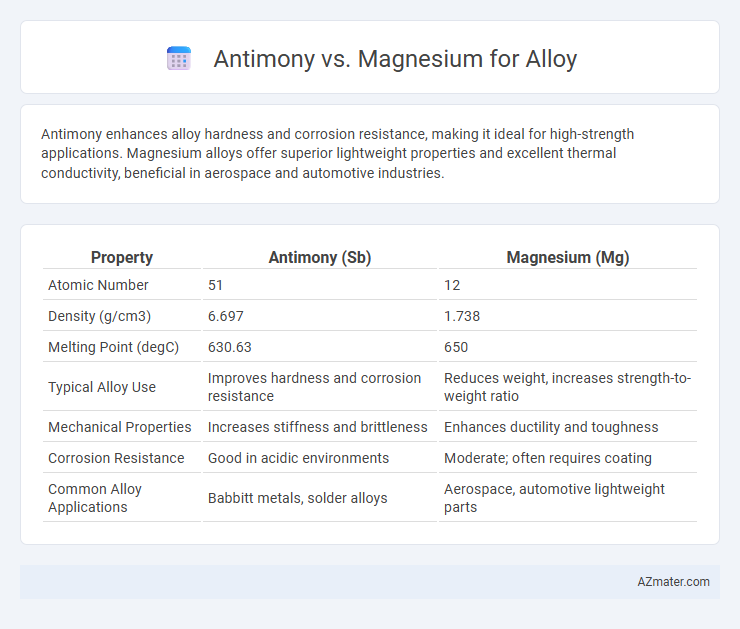Antimony enhances alloy hardness and corrosion resistance, making it ideal for high-strength applications. Magnesium alloys offer superior lightweight properties and excellent thermal conductivity, beneficial in aerospace and automotive industries.
Table of Comparison
| Property | Antimony (Sb) | Magnesium (Mg) |
|---|---|---|
| Atomic Number | 51 | 12 |
| Density (g/cm3) | 6.697 | 1.738 |
| Melting Point (degC) | 630.63 | 650 |
| Typical Alloy Use | Improves hardness and corrosion resistance | Reduces weight, increases strength-to-weight ratio |
| Mechanical Properties | Increases stiffness and brittleness | Enhances ductility and toughness |
| Corrosion Resistance | Good in acidic environments | Moderate; often requires coating |
| Common Alloy Applications | Babbitt metals, solder alloys | Aerospace, automotive lightweight parts |
Introduction to Antimony and Magnesium Alloys
Antimony alloys are widely used for their excellent hardness, corrosion resistance, and improved mechanical properties, often serving in battery components, bearings, and solder materials. Magnesium alloys stand out for their lightweight nature, high strength-to-weight ratio, and superior machinability, making them ideal for automotive, aerospace, and electronics applications. The combination of antimony with other metals typically enhances wear resistance, while magnesium alloys prioritize weight reduction and structural integrity in engineering designs.
Chemical and Physical Properties Comparison
Antimony and magnesium exhibit distinct chemical and physical properties that influence their alloy applications. Antimony is a brittle metalloid with a high melting point of 630.63degC and excellent corrosion resistance, often used to improve hardness and strength in lead alloys. Magnesium, a lightweight metal with a melting point of 650degC, offers superior strength-to-weight ratio and corrosion resistance, making it ideal for lightweight, high-performance alloys in automotive and aerospace industries.
Applications of Antimony Alloys
Antimony alloys are commonly used in applications requiring increased hardness, wear resistance, and flame retardancy, such as in battery grids, cable sheathing, and automotive brake components. Unlike magnesium alloys, which prioritize lightweight and high strength for aerospace and automotive body panels, antimony enhances mechanical properties and corrosion resistance in lead-based alloys. The addition of antimony improves the durability and stability of alloys in demanding industrial environments.
Applications of Magnesium Alloys
Magnesium alloys are extensively used in aerospace, automotive, and electronics industries due to their lightweight and high strength-to-weight ratio, enhancing fuel efficiency and performance. They offer excellent machinability, corrosion resistance, and thermal conductivity, making them ideal for structural components and casings. Compared to antimony, which is primarily used for improving hardness and flame retardancy, magnesium alloys provide superior weight reduction and mechanical properties essential for advanced engineering applications.
Strength and Durability: Antimony vs Magnesium
Antimony alloys exhibit superior strength and wear resistance compared to magnesium alloys, making them ideal for applications requiring enhanced durability under high stress. Magnesium alloys, while lightweight and corrosion-resistant, generally offer lower tensile strength and fatigue resistance than antimony-based counterparts. The choice between antimony and magnesium alloys depends largely on the specific balance of mechanical robustness and weight savings needed for the application.
Corrosion Resistance Differences
Antimony alloys exhibit superior corrosion resistance compared to magnesium alloys due to their enhanced ability to form protective oxide layers and resist chemical degradation in harsh environments. Magnesium alloys, while lightweight and strong, are more prone to oxidation and galvanic corrosion, especially in marine or acidic conditions. The inclusion of antimony in alloys significantly improves durability by reducing susceptibility to corrosion-related failures.
Weight and Density Considerations
Antimony has a density of approximately 6.7 g/cm3, making it significantly heavier than magnesium, which has a density of about 1.74 g/cm3. When used in alloys, the higher density of antimony contributes to increased weight, impacting the overall mass of the material. Magnesium's low density makes it ideal for lightweight alloys in aerospace and automotive applications where weight reduction is critical.
Cost and Availability of Materials
Antimony is generally more expensive and less abundant than magnesium, impacting the overall cost of alloys where it is used as an additive. Magnesium's higher availability and lower market price make it a cost-effective choice for alloy production, especially in large-scale industrial applications. The cost-efficiency and widespread supply of magnesium contribute to its preference in alloys designed for lightweight and durable materials.
Environmental Impact and Safety
Antimony alloys often raise environmental concerns due to the toxic nature of antimony compounds, which can contaminate soil and water during mining and disposal, posing risks to human health and ecosystems. Magnesium alloys offer a safer environmental profile with lower toxicity and are highly recyclable, reducing waste and energy consumption in metal production. Choosing magnesium over antimony in alloy applications promotes sustainability by minimizing hazardous waste while maintaining corrosion resistance and lightweight properties.
Choosing the Right Alloy: Key Factors
When choosing between antimony and magnesium for alloys, key factors include strength, weight, and corrosion resistance. Antimony improves hardness and wear resistance in alloys like lead or tin, making it ideal for applications requiring durability and dimensional stability. Magnesium alloys offer superior lightweight properties and excellent strength-to-weight ratios, suited for aerospace and automotive industries prioritizing fuel efficiency and performance.

Infographic: Antimony vs Magnesium for Alloy
 azmater.com
azmater.com